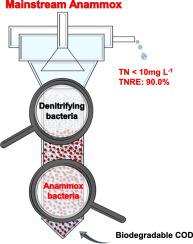Science of the Total Environment ( IF 8.2 ) Pub Date : 2022-08-19 , DOI: 10.1016/j.scitotenv.2022.158191 Ya-Fei Cheng 1 , Zheng-Zhe Zhang 1 , Wen-Jie Ma 1 , Gui-Feng Li 1 , Bao-Cheng Huang 1 , Nian-Si Fan 1 , Ren-Cun Jin 1

|
The inevitable introduction of biodegradable carbon sources (such as monosaccharides and volatile fatty acids) originating from pretreatment units might affect the performance of the mainstream anaerobic ammonium oxidation (anammox) process. Two model carbon sources (glucose and acetate) were selected to investigate their effects on granule-based anammox systems under mainstream conditions (70 mg total nitrogen (TN) L−1, 15 °C). At a nitrogen loading rate of 2.87 ± 0.80 kg N m−3 d−1, a satisfactory effluent quality (TN < 10 mg L−1) was achieved in the presence of glucose or acetate at a chemical oxygen demand (COD/N) ratio of 0.5. The contribution of anammox to nitrogen removal decreased with increasing COD/N ratio to 1.0 because the expression of anammox functional genes was inhibited, whereas the expression of denitrifying functional genes was promoted. However, the nitrogen removal efficiency of the two considered reactors was maintained above 80 %. Self-stratification of the microbial community along the reactor height facilitated a functional balance through the retention of anammox bacteria in granules but resulted in washout of denitrifying bacteria in flocs under a high-flow pattern. These findings highlighted the advantages of granule-based systems in the mainstream anammox process due to their inherent biomass self-segregation property and the need for the development of targeted biomass retention strategies.
中文翻译:

主流厌氧氨氧化工艺对颗粒系统中可生物降解碳源的响应:微生物群落自分层的差异
源自预处理单元的可生物降解碳源(如单糖和挥发性脂肪酸)的不可避免的引入可能会影响主流厌氧氨氧化(anammox)工艺的性能。选择了两种模型碳源(葡萄糖和乙酸盐)来研究它们在主流条件(70 mg 总氮 (TN) L -1 , 15 °C)下对基于颗粒的厌氧氨氧化系统的影响。在 2.87 ± 0.80 kg N m -3 d -1的氮负荷率下,出水水质令人满意(TN < 10 mg L -1) 是在葡萄糖或醋酸盐存在下以 0.5 的化学需氧量 (COD/N) 比率实现的。厌氧氨氧化对氮去除的贡献随着 COD/N 比值增加到 1.0 而降低,因为厌氧氨氧化功能基因的表达受到抑制,而反硝化功能基因的表达被促进。然而,所考虑的两个反应器的脱氮效率保持在 80% 以上。微生物群落沿反应器高度的自分层通过将厌氧氨氧化细菌保留在颗粒中促进了功能平衡,但在高流量模式下导致絮凝物中的反硝化细菌被冲走。















































 京公网安备 11010802027423号
京公网安备 11010802027423号